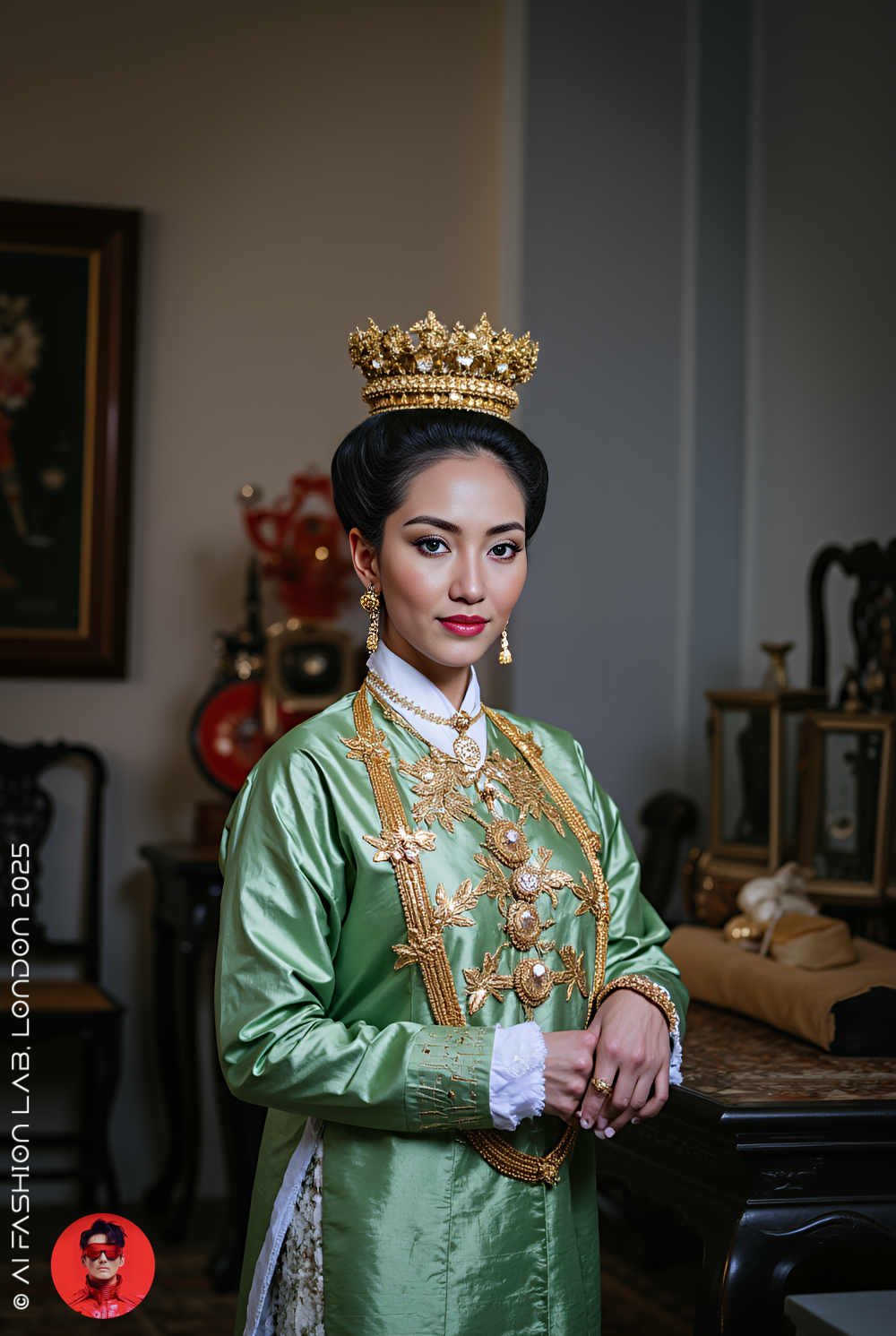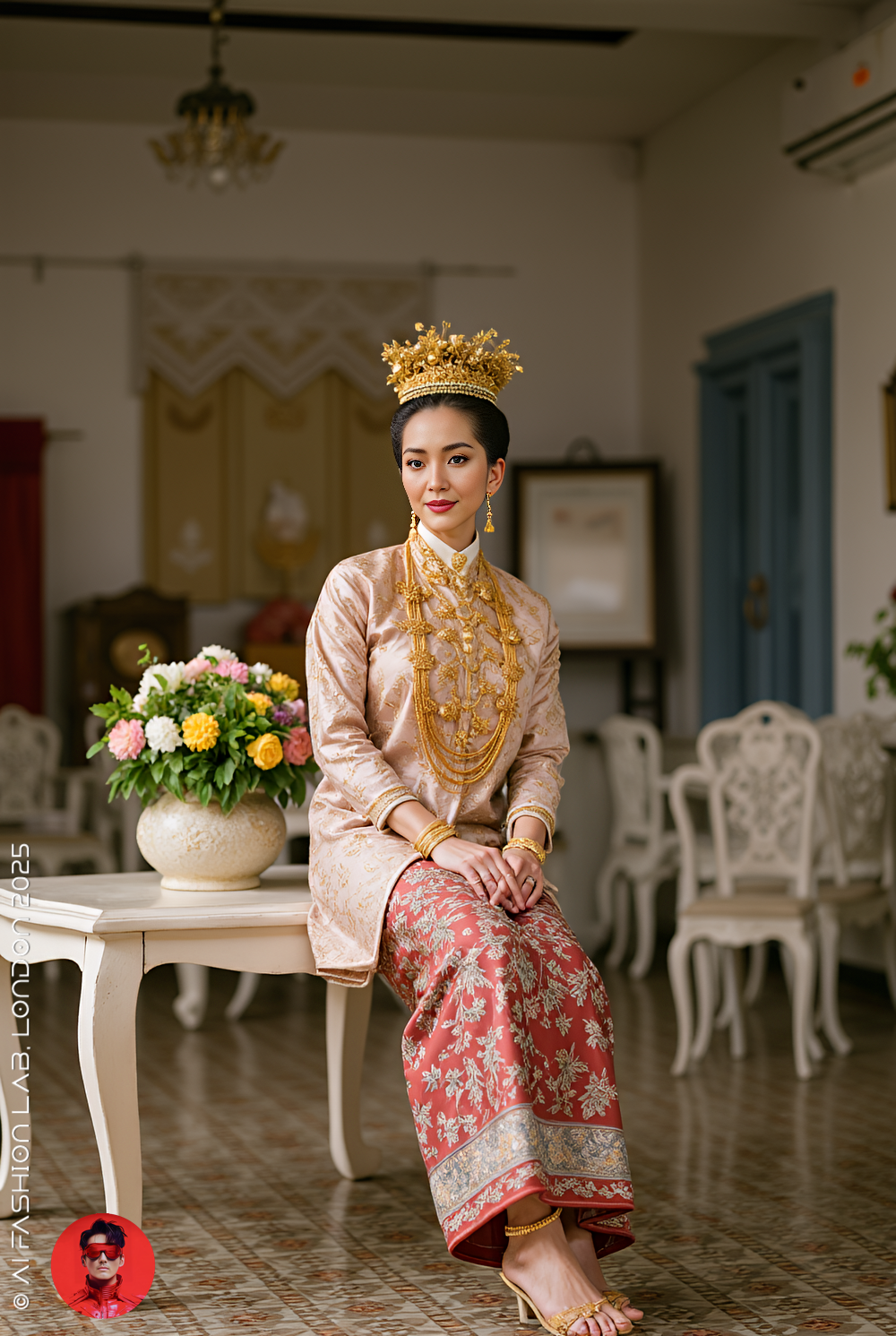ประวัติศาสตร์แฟชั่นงานแต่งงานในวัฒนธรรมเพอรานากัน: การแต่งกายของเจ้าบ่าวและเจ้าสาว (ตอนที่ 2)
“บาบ๋า” และ “ย่าหยา” ในชุดแต่งงานเพอรานากันยุค 1930s — เจ้าบ่าวในทักซิโด้สากลตะวันตก และเจ้าสาวในเสื้อย่าหยาผ้าไหมคู่กับโสร่งบาติกแบบมลายู
✧ ประวัติศาสตร์แฟชั่นงานแต่งงานในวัฒนธรรมเพอรานากัน: การแต่งกายของเจ้าบ่าวและเจ้าสาว (ตอนที่ 2)✧
คอลเลกชันภาพ AI ชุดนี้ถ่ายทอดความงามเหนือกาลเวลาแห่งวัฒนธรรมบาบ๋า-ย่าหยา โดยมีทั้งเจ้าบ่าวและเจ้าสาว ซึ่งได้รับแรงบันดาลใจจากรูปถ่ายงานแต่งงานเพอรานากันต้นฉบับในคาบสมุทรมลายูช่วงทศวรรษ 1930s
หนึ่งในวัฒนธรรมที่ผสมผสานอย่างสวยงามและลงตัวในเอเชียตะวันออกเฉียงใต้คือ วัฒนธรรมเพอรานากัน (Peranakan) หรือที่รู้จักในชื่อ บาบ๋า-ย่าหยา ซึ่งเป็นการผสมผสานระหว่างวัฒนธรรมจีนและมลายู โดยเฉพาะในพื้นที่ สิงคโปร์ มาเลเซีย และภาคใต้ของประเทศไทย เช่น ภูเก็ต
✧ รากเหง้าทางวัฒนธรรมของชาวเพอรานากัน ✧
เพอรานากันเกิดจากการแต่งงานระหว่างผู้อพยพชาวจีนที่มาตั้งรกรากในคาบสมุทรมลายูกับหญิงพื้นเมืองในท้องถิ่น ลูกหลานชายถูกเรียกว่า “บาบ๋า” และฝ่ายหญิงเรียกว่า “ย่าหยา” โดยชุมชนนี้พัฒนาเอกลักษณ์เฉพาะตัวที่เห็นได้ชัดเจนในภาษา อาหาร สถาปัตยกรรม และ เครื่องแต่งกาย ซึ่งกลายเป็นมรดกทางวัฒนธรรมที่โดดเด่นยิ่งในภูเก็ต
✧ ชุดเจ้าสาวเพอรานากัน ✧
การแต่งกายของเจ้าสาวเพอรานากัน ในยุค 1930s นั้นอุดมไปด้วยรายละเอียดที่สะท้อนถึงรสนิยม ความประณีต และฐานะของผู้สวมใส่ ชุดเจ้าสาวส่วนใหญ่ประกอบด้วยเสื้อและผ้าที่ได้รับอิทธิพลจากวัฒนธรรมมลายูอย่างชัดเจน ได้แก่:
เสื้อย่าหยา (Kebaya Nyonya) ซึ่งเป็นเสื้อคลุมบางเบา ปักลวดลายอย่างละเอียดด้วยมือ โดยเฉพาะลายดอกไม้ ผีเสื้อ และสัตว์มงคล ลักษณะของเสื้อนี้ได้รับแรงบันดาลใจจากเสื้อคลุมของชาวมลายูที่ปรับให้เข้ากับสไตล์ของผู้หญิงเชื้อสายจีน
โสร่งผ้าปาเต๊ะ (Batik Sarong) ที่มีลวดลายเฉพาะตัว สะท้อนรากเหง้าของงานหัตถกรรมชาวมลายู ซึ่งภายหลังถูกผสมผสานกับลวดลายจีนจนเกิดเป็นแบบฉบับเฉพาะของเพอรานากัน
เข็มกลัดกอรอสัง (Kerongsang) สามชิ้น ใช้กลัดเสื้อแทนกระดุม
ฮั้วก๋วน (Hua Guan) มงกุฎดอกไม้ไหวประจำวันแต่งงาน
เสื้อผ้าและเครื่องแต่งกายของเจ้าสาวเพอรานากันจึงถือเป็นการผสมผสานศิลปะการแต่งกายของจีนและมลายูไว้อย่างงดงาม เกิดเป็นสไตล์เฉพาะที่ไม่เหมือนใคร
✧ ชุดเจ้าบ่าวเพอรานากัน ✧
เจ้าบ่าวในยุค 1930s มักแต่งกายด้วยแบบสากลตะวันตกผสมกลิ่นอายท้องถิ่น ประกอบด้วย:
สูทตัดเย็บประณีต สีขาวหรือครีม
รองเท้าหนังขัดมัน
เครื่องประดับสำคัญของเจ้าบ่าว ได้แก่
ปิ่นตั้ง (Bintang) เข็มกลัดรูปดาว 6 หรือ 8 แฉก ทรงกลมนูน ซึ่งส่วนใหญ่มักประดับด้วยเพชรเพื่อบ่งบอกยศถาบรรดาศักดิ์
คอสาร์ท (Corsage) ที่ทำจาก ขนกระต่าย สวมไว้ที่หน้าอก สื่อถึงการเป็นเจ้าบ่าวโดยเฉพาะ
ทั้งปิ่นตั้งและคอสาร์ทของเจ้าบ่าวจะปรากฏเฉพาะในวันแต่งงานเท่านั้น
✧ มรดกเพอรานากันในภูเก็ต ✧
ย่านเมืองเก่าภูเก็ตคือศูนย์รวมของวัฒนธรรมเพอรานากัน ไม่ว่าจะเป็นบ้านเรือนสไตล์ชิโน-โปรตุกีส อาหารฟิวชันเอเชีย และ การแต่งกายบาบ๋า-ย่าหยา ที่ยังคงพบเห็นได้ในงานเทศกาลท้องถิ่น โดยเฉพาะใน เทศกาลแต่งงานบาบ๋า-ย่าหยา ซึ่งจัดขึ้นทุกปีและได้รับความนิยมจากทั้งชาวไทยและนักท่องเที่ยว ว่ากันว่ามากกว่า 70% ของชาวภูเก็ตมีเชื้อสายเพอรานากัน ทำให้เมืองนี้เปรียบเสมือนพิพิธภัณฑ์มีชีวิตแห่งวัฒนธรรมจีน-มลายู
✧ AI กับการอนุรักษ์มรดกทางวัฒนธรรม ✧
คอลเลกชันนี้เป็นการ สร้างภาพด้วย AI โดยได้รับแรงบันดาลใจจาก4krงานแต่งงานเพอรานากันยุค 1930s ทุกภาพผ่านการออกแบบอย่างละเอียดอ่อน เพื่อถ่ายทอดรายละเอียดของ แฟชั่น ผ้า เครื่องประดับ และอารมณ์ของเจ้าบ่าว-เจ้าสาว ได้อย่างใกล้เคียงของจริงที่สุด แม้จะไม่ได้เป็นภาพถ่ายจริง แต่เป็นผลงานที่สร้างขึ้นด้วยเทคโนโลยีเพื่อถ่ายทอดความงามเหนือกาลเวลาของวัฒนธรรมเพอรานากัน
✧ The History of Peranakan Wedding Fashion: Traditional Attire of the Bride and Groom (Part 2)✧
This AI-generated collection captures the timeless beauty of Baba-Nyonya culture, featuring both the bride and groom, inspired by original 1930s Peranakan wedding photographs from the Malay Peninsula.
One of the most intricately blended cultures in Southeast Asia is that of the Peranakan, also known as Baba-Nyonya. This cultural fusion between Chinese and Malay traditions is particularly prominent in Singapore, Malaysia, and southern Thailand, especially in Phuket.
✧ Cultural Origins of the Peranakan Community ✧
The Peranakan community emerged from intermarriages between Chinese immigrants who settled in the Malay Peninsula and local indigenous women. Male descendants are known as Baba, while female descendants are referred to as Nyonya. Over generations, this community developed a unique cultural identity—clearly reflected in its language, cuisine, architecture, and most notably, attire—which became a defining cultural heritage in Phuket.
✧ The Peranakan Bride ✧
The wedding attire of a Peranakan bride in the 1930s was rich in intricate detail, reflecting refined taste, craftsmanship, and social standing. The bridal outfit prominently featured garments influenced by traditional Malay clothing, including:
Kebaya Nyonya – a delicate, sheer blouse layered with intricate hand embroidery, often depicting flowers, butterflies, and auspicious animals. This style was adapted from Malay outerwear and reimagined for Chinese-descended women.
Batik Sarong – a tube skirt made from hand-drawn batik fabric featuring distinctive patterns, combining traditional Malay textile craftsmanship with Chinese-inspired motifs, forming a uniquely Peranakan expression.
Kerongsang – a set of three ornamental brooches used to fasten the kebaya in place, replacing buttons and adding a decorative touch.
Hua Guan – a floral bridal crown worn only on the wedding day, crafted from 144 individual hairpins given by the bride’s female relatives. The crown traditionally featured phoenixes or delicate gold-threaded flowers that fluttered with movement, symbolising the bride’s tender heart on her wedding day.
The bride’s attire, combining Chinese and Malay dress artistry, exemplified the elegance of a culture born of beautiful fusion.
✧ The Peranakan Groom ✧
Grooms of the 1930s typically embraced a Western-inspired style fused with cultural significance. The groom’s attire often included:
A tailored suit, usually in white or cream
Polished leather shoes
Symbolic accessories worn exclusively on the wedding day:
Bintang – a star-shaped brooch with 6 or 8 points, often adorned with diamonds to signify status or noble rank
Corsage – traditionally made from rabbit fur, pinned to the chest to clearly mark the wearer as the groom
Both the Bintang and corsage were worn only during the wedding ceremony, representing the groom's honour and distinctive role.
✧ Peranakan Heritage in Phuket ✧
Phuket Old Town stands as a vibrant showcase of Peranakan heritage. From the iconic Sino-Portuguese architecture, fusion cuisine, to the continued practice of Baba-Nyonya dress, the influence is deeply embedded in local identity. The Baba Wedding Festival, held annually, is a beloved celebration that draws both locals and tourists alike.
It is believed that more than 70% of Phuket's population has Peranakan ancestry, making the island a living museum of Chinese-Malay cultural legacy.
✧ AI and the Preservation of Cultural Heritage ✧
This image collection was created with AI technology, inspired by vintage Peranakan wedding portraits from the 1930s. Each composition is carefully crafted to convey the fashion, textiles, jewellery, and emotions of the bride and groomwith as much historical authenticity as possible.
Though not real photographs, these are AI-enhanced creations designed to honour and preserve the timeless beauty of Peranakan culture through a new visual medium.
#aifashionlab #AI #aiartist #aiart #aifashion #aifashiondesign #aifashionstyling #aifashiondesigner #fashion #fashionhistory #historyoffashion #fashionstyling #fashionphotography #digitalfashion #digitalfashiondesign #digitalcostumedesign #digitaldesign #digitalaiart #ThaiFashionHistory #ThaiFashionAI #flux #fluxlora
















































































